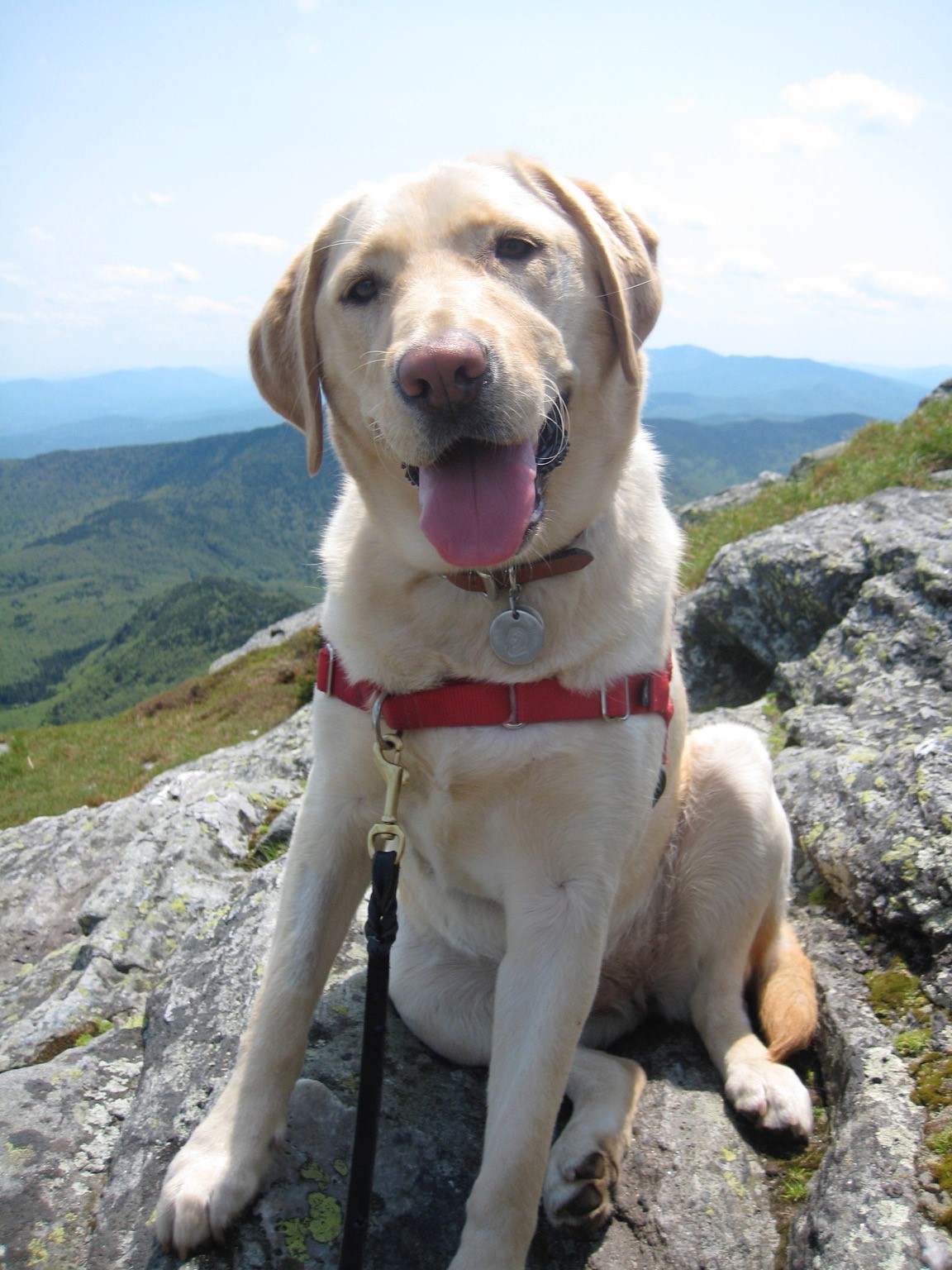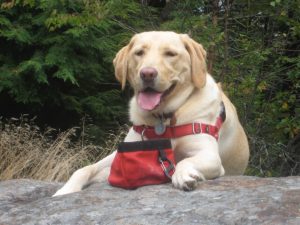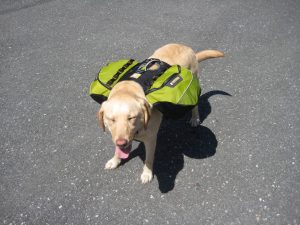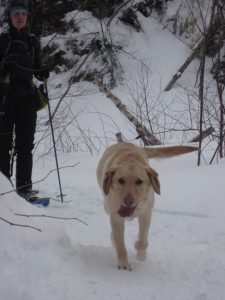Hiking the Adirondacks with Man’s Best Friend

I have two yellow Labrador Retrievers named Una and Ziggy who are 8 and 5, respectively. Not surprisingly, they’re both rather active, high-energy dogs who thrive on outdoor physical exertion. Since my husband and I are both fairly avid hikers (he’s five High Peaks away from achieving 46-er status), it occurred to us that the Adirondacks, which are practically in our backyard, may offer exactly what our dogs need: a challenging terrain for human and canine alike that’s accessible and enjoyable year-round by other like-minded people who love the outdoors and are only too happy to see two goofy, happy Labs barreling up and down the trail. Before we set out on our first adventure with dogs in tow, we knew some preparation was in order. 
Research Boasting more than 100 peaks, 46 of which have been dubbed the “High Peaks” given their 4,000-plus foot summits, the Adirondacks require some research before deciding which mountain to tackle. Some things you’ll want to consider include:
- Time of year. This is a big one. If you decide to go after daylight savings time ends (November – March), not only are you in for some frigid temperatures (more on this later), you’re also contending with shorter days. The sun rises between 7 and 7:30 a.m. and sets between 4 and 4:30 p.m., so getting an early start is crucial if you want to avoid a return trip in the dark. This being the great Northeast, snow and ice are two major factors that should never be overlooked, as they can make or break your trip. If you’re not a fan of either, you might want to schedule your excursions for the summer and fall. Keep in mind that the Adirondacks are farther north and at a much higher elevation, so while it might be a mild day in Albany, the conditions in the mountains could be colder, windier, and snowier. The NYS Department of Environmental Conservation provides a weather forecast, trail conditions, and a plethora of other helpful information for seasoned hikers and newbies.
- Temperature. As I alluded to earlier, temperature is not something you want to take lightly, especially in the colder months. Sub-zero temps are commonplace in the Adirondacks and can make for a dreadful and sometimes dangerous experience. Plus, you’ll want to think about your furry companion and whether he/she is up to the task. Hardier breeds might fare OK, but I’d still use caution. On the other end of the spectrum are extreme heat and humidity. While the climate is generally cooler in the mountains, you and your dog can still work up a decent sweat in the summer, and you’ll want to make sure you have plenty of water for everyone. Keep reading for more details on what equipment you’ll need.
- Distance. This is two-fold: How far do you want to drive and how far do you want to hike? The official Adirondacks website is a good resource for determining which mountain best suits you and your friends, both two-legged and four-legged. Puppies and senior dogs are probably not cut out for a 15-mile roundtrip trek up and down a mountain.
- Dog breed and size. To ensure that your puppy pal has a fun, positive experience and stays injury-free, you should definitely tailor your hiking trip to his/her size, health, and breed. You know your dog best and what his/her limitations are, if any.
Clothing (For You and Man’s Best Friend) Deciding what to wear on your hike greatly depends on the aforementioned time of year and temperature. During the colder months, layers that you can easily shed, or put back on, as your body temperature adjusts to the climate and your activity level are highly advisable. Here’s a quick rundown on the recommended attire for a fall/winter trek:
- A base layer made from a synthetic wicking material (not cotton) to help you stay warm and dry
- The second layer should be an insulating material like fleece
- The outer layer should be wind- and waterproof
- Don’t forget a hat, gloves, wool socks, and waterproof boots as well

Since your dog comes equipped with his or her own coat, anything additional really isn’t necessary and may even cause your pal to overheat. While these certainly aren’t necessary either, I have to mention them because they’re downright adorable: boots. I’ve only seen sled dogs wear them, and more than likely your dog’s paws are the only footwear he/she will ever need. However, if you’re concerned about their comfort, and if they aren’t stricken with spontaneous paralysis as soon as you put something on their feet (like my dogs), you can find boots at EMS and other outdoor specialty stores.
In the late spring and summer, you’ll want to sport sweat-wicking clothing and take along a rain jacket in case you are caught in a stray shower.
Equipment This also depends on the time of year. In the winter, make sure you pack extra socks and gloves in case what you’re wearing gets wet. Extra socks could come in handy in the summer, too. Also, keep in mind that your dog can carry his/her own food, water, and anything else considered essential in a canine’s mind (treats, extra leash and collar, perhaps) in a specially designed pack. Here are a few other items you won’t want to forget: 
- Water: Take as much as you, and your pup, can comfortably carry.
- Snacks: Granola bars, nuts, dried fruit, and trail mix are energizing and lightweight. Don’t forget to toss some extra kibble in your pup’s pack.
- Sun protection: This includes a wide-brimmed hat, sunscreen, and sunglasses. You’ll want and need the last two items in the winter as well.
- First–aid kit: Pack enough adhesive bandages, alcohol wipes, and antibiotic ointment for you and your pup.
- Bag for collecting trash: Carry out what you carry in.
- Compass and map: If you veer off the trail, these might come in handy. Just make sure you know how to use them. And, remember that cell service in the Adirondacks is spotty at best.
- Duct tape: You can use it as a bandage, to repair holes in shoes, seal cracks in water bottles, and probably much more.
- Flashlight/headlamp: Even if you don’t plan to be out after dark, it can be useful if your hike takes longer than expected. Don’t forget extra batteries.
- Snowshoes and/or crampons: These are a godsend in snowy, icy conditions and can be rented at EMS and the Adirondack Loj.
Where to Go As previously mentioned, the main Adirondacks site is a good place to start planning your hike. The Adirondack Mountain Club site is also excellent. Plus, if you decide to join, your membership dues will help fund preservation efforts, among other worthy causes.
Here’s a list of mountains and trails that we’ve hiked so far, dogs by our side. Not all are High Peaks, and some are definitely easier than others. Keep in mind that your furry pal must stay on-leash throughout the duration of your hike, lest you get a warning/admonishment from a park ranger.
- Buck Mountain: Right near the village of Lake George, this hike is ideal for beginners and offers a spectacular view of the High Peaks. Buck is near and dear to my heart, as it was my and Una’s first official hike in the Adirondacks. Since it’s not too far north and not too high, you can easily conquer Buck and return home with plenty of daylight to spare. However, beware of the false summit. Just when you think your climb is over, you still have a bit more to go.
- Porter: We tackled this peak not too long after Buck, and I remember it being challenging but manageable thanks to its lower elevation. While you’re at it, you might as well climb Cascade since your descent will most likely end at the Cascade trailhead. Either way, you’ll be rewarded with amazing views on both peaks. Remember that these mountains are still steep and rocky, so the right footwear and plenty of water are essential. Also, these peaks are popular, and while they’re perfect for dogs, you’ll definitely want to keep them on a leash. Ziggy wasn’t in the picture yet, but Una absolutely loved this hike.
- Hadley: Only 3.2 miles roundtrip, you’ll enjoy a relatively quick and easy trek up, followed by views of the High Peaks to the north, the Green Mountains and Berkshires to the east, and the Catskills to the south. Located near Lake George, Hadley is yet another fun, dog-friendly option that won’t eat up your entire day.
- Esther: This mountain is definitely on the more challenging side, as it’s higher and therefore takes longer to climb. We actually hiked Esther in the winter in snowshoes, which I highly recommend. Yes, it’s cold, but instead of scaling large rocks and boulders, you’re dealing with a steady incline that, in the long-run, is much easier. Both dogs came along and were in their glory.
- Algonquin: This being the second-highest peak in the Adirondacks, prepare yourself for a long, challenging, but rewarding, hike. We first snowshoed up neighboring Wright and then tackled this mountain. What I remember most was the 60-mile-per-hour wind at the summit that almost knocked me down. The dogs were impervious and had a grand ole time. I chalk it up to their low center of gravity and two extra legs.
- Street and Nye: Similar to Cascade and Porter, if you’re going to climb one, you might as well climb the other and knock two High Peaks off the list. Of course, plan for a full day and leave early so you have enough daylight. The ascents weren’t difficult, but the overall experience was exhausting. Summiting two peaks is no joke.

- Mt. Jo: We also climbed this peak on snowshoes. As I said – it’s easier in the winter. The view was gorgeous and the roundtrip trek only took us a couple of hours.
- Avalanche Lake/Pass: This is a great option if you happen to be near Lake Placid and don’t feel like conquering a mountain. We went snowshoeing here a few years ago with the dogs and took full advantage of the Adirondack Loj to warm up pre- and post-hike. We made it to about Avalanche Lake and then called it a day. The scenery was beautiful and the trail not too demanding up to that point.
- Johns Brook Trail: Here’s another easy option for novices or those looking to take a casual stroll and commune with nature. Located in Keene Valley, the trail leads to the Johns Brook Lodge, a perfectly rustic structure where you can purchase last-minute necessities or even stay the night. We visited during the fall and it was glorious. I’ll admit that we let the dogs off-leash for a few minutes so they could splash around in the brook.

That about wraps up our hiking adventures with our dogs so far. I plan to add to this post as we conquer more mountains and explore new trails. Please don’t hesitate to share your own outdoor “tails” in the comments section. I’d love to read them for ideas on where to go next.
Also, this is by no means a complete hiking how-to. I highly encourage you to conduct your own thorough research on where and when to go and what to pack. Have fun exploring and stay safe!
 The Daily Dose
The Daily Dose
 Suzanne Huwe
Suzanne Huwe
Spencer Foisy
I would add to this that you should be physically able to carry your dog in case of injury. My golden retriever sliced a foot pad on a sharp stone hiking up rocky peak ridge. He hobbled on it for about a half mile before laying down on the trail. He refused to walk further. I had to carry all 80 lbs of him for 3.5 miles out of the woods. The DEC will only offer assistance for humans.
Suzanne Huwe
Thanks for your comment, Spencer! This is an excellent point and one that I meant to include and completely forgot about. So, thank you again!